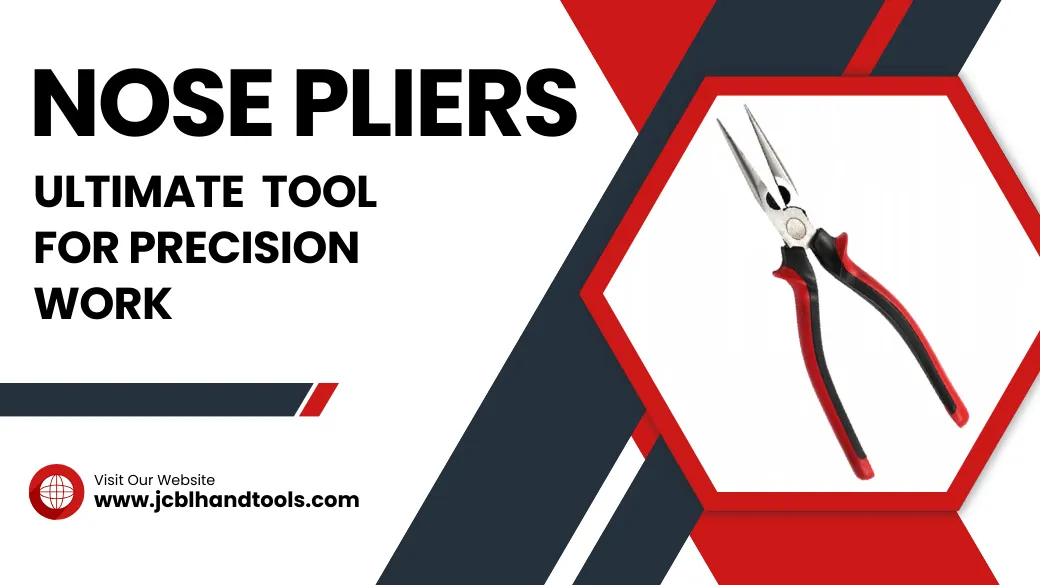Nose pliers are one of the most versatile tools in repair and maintenance work among professionals and DIY enthusiasts. These are especially used while working with small objects, intricate wiring, or delicate crafting. Whether you are an electrician, a jeweler, or a hobbyist, nose pliers provide the precision and control necessary to complete intricate tasks effectively. In this blog, we will explore what nose pliers are, their types and uses, how to use them properly, and how to maintain them for long-lasting performance.
What Are Nose Pliers?
Nose pliers, also known as long-nose or needle-nose pliers, are a type of hand tool designed for gripping, bending, and manipulating small objects. Their long, tapered jaws allow users to reach into tight spaces, making them ideal for precision tasks. Unlike regular pliers, nose pliers offer better control and flexibility, which is essential when working with delicate materials like jewelry, wires, and small mechanical components.
These pliers are commonly used in electrical work, jewelry making, crafting, and mechanical applications. They are often equipped with insulated handles for electrical safety and may include built-in cutting edges to trim wires and other materials.
Types Of Nose Pliers And Their Uses
Nose pliers come in various shapes and sizes, each designed for specific applications. Whether you’re working on intricate jewelry-making, electrical work, or mechanical repairs, selecting the right type of nose pliers can significantly improve precision and efficiency. Understanding their differences can help you choose the right tool for your needs.
Long-nose Pliers
Long-nose pliers, also known as snipe-nose pliers, feature elongated, tapered jaws that provide excellent reach and precision. Their design allows users to grip small objects and work in tight spaces, making them invaluable in electrical, mechanical, and craft applications. The narrow tip ensures superior control, enabling intricate wire bending, cutting, and placement. Made from durable steel, they often include insulated handles for safety. Their versatility and ability to access confined areas make them essential for professionals and DIY enthusiasts alike.
Needle-nose Pliers
Needle-nose pliers are designed with exceptionally slim, pointed jaws that allow for precision work in delicate and confined environments. They are ideal for handling fine wires, positioning components, and intricate bending tasks. The smooth or serrated inner jaws provide a secure grip without damaging delicate materials. Commonly used in jewelry making, electrical repairs, and fine mechanical work, needle-nose pliers often include a built-in cutting edge. Their ergonomic handles provide comfort and control, making them indispensable for detailed craftsmanship.
Bent-Nose Pliers
Bent-nose pliers have angled jaws, typically at 45° or 90°, enabling access to hard-to-reach areas. This unique design provides better visibility when gripping, twisting, or manipulating small parts. Used in electronics, jewelry-making, and mechanical repairs, these pliers allow for precise maneuvering without obstructing the line of sight. The curved jaws make them perfect for tasks requiring a firm grip at an angle. Often featuring cushioned grips, bent-nose pliers reduce hand fatigue and enhance comfort for prolonged use.
Round-Nose Pliers
Round-nose pliers feature smooth, rounded jaws that taper towards the tip, making them ideal for shaping, looping, and coiling wire. Primarily used in jewelry-making and crafting, they allow artisans to create consistent curves without damaging the material. These pliers are essential for forming jump rings, clasps, and decorative wire elements. Due to their non-serrated jaws, they prevent scratches or dents on delicate materials. Many round-nose pliers come with comfortable grips, ensuring better control for intricate metalworking and artistic projects.
Chain-Nose Pliers
Chain-nose pliers have short, tapered jaws with flat inner surfaces, offering a firm yet gentle grip on small components. They are widely used in jewelry-making, electronics, and mechanical repairs for tasks like gripping, shaping, and crimping. Their fine tips allow access to tight spaces, making them excellent for detailed wirework and assembly. With smooth or lightly serrated jaws, they provide secure handling without damaging delicate materials. Ergonomic handles enhance comfort and control, making chain-nose pliers a versatile tool for precision work.
How To Use Nose Pliers Effectively
Using nose pliers correctly ensures safety and optimal performance. Here are some essential tips for effective use:
- Choose the Right Pliers: Selecting the appropriate type of nose pliers for your task is crucial. Using the wrong pliers can damage the material or cause unnecessary strain on your hands.
- Hold the Pliers Properly: Grip the handles firmly but not too tightly. Excessive force can lead to hand fatigue and reduced control over delicate tasks.
- Apply Gradual Pressure: When bending or gripping objects, apply steady and gradual pressure to avoid breaking or deforming the material.
- Use the Cutting Edge Carefully: Many nose pliers come with built-in wire cutters. Use them only for their intended purpose, and avoid cutting materials that are too thick for the pliers’ capacity.
- Avoid Overloading: Do not use nose pliers for heavy-duty tasks beyond their design capabilities. Overloading can damage the jaws and reduce the tool’s lifespan.
Following these best practices will help you achieve precise results while prolonging the life of your nose pliers.
How To Maintain Nose Pliers For Longevity
Proper maintenance is essential to keep your nose pliers in top working condition. Here are some maintenance tips to ensure durability:
- Clean After Use: Wipe your pliers with a dry cloth after each use to remove dirt, grease, or debris. For sticky residues, use a mild solvent or rubbing alcohol.
- Lubricate Moving Parts: Apply a small amount of machine oil to the joint to ensure smooth movement and prevent rusting.
- Store Properly: Store your pliers in a dry place, preferably in a toolbox or a hanging rack. Avoid leaving them in humid environments to prevent rust.
- Check for Wear and Tear: Regularly inspect the jaws and cutting edges for signs of wear. Replace the pliers if the jaws no longer align properly or if the cutting edges become dull.
- Avoid Using for the Wrong Purpose: Using nose pliers for prying or as a hammer can cause damage. Always use the right tool for the job.
With proper care, your nose pliers can remain functional for years, saving you the hassle and cost of frequent replacements.
Conclusion
Nose pliers are an indispensable tool for precision work, offering versatility and control in various applications. Whether you’re an electrician, jeweler, or DIY enthusiast, having a reliable pair of nose pliers can make your work more efficient and precise.
For high-quality, durable nose pliers, look no further than JCBL Hand Tools. Our premium selection ensures superior performance, ergonomic design, and long-lasting durability. Upgrade your toolbox today with the best pliers from JCBL Hand Tools and experience precision like never before!
For any queries, contact us at +91-9815579321 or email us at handtools@jcbl.com.
FAQs
What is the difference between long-nose pliers and needle-nose pliers?
Long-nose pliers have slightly thicker jaws compared to needle-nose pliers, which are slimmer and better suited for fine, intricate work.
Can nose pliers cut the wire?
Many nose pliers have built-in cutting edges for soft wire cutting, but they may not be suitable for heavy-duty wire cutting.
How do I prevent rust on my nose pliers?
Keep them clean, dry, and lubricated. Store them in a moisture-free environment.

